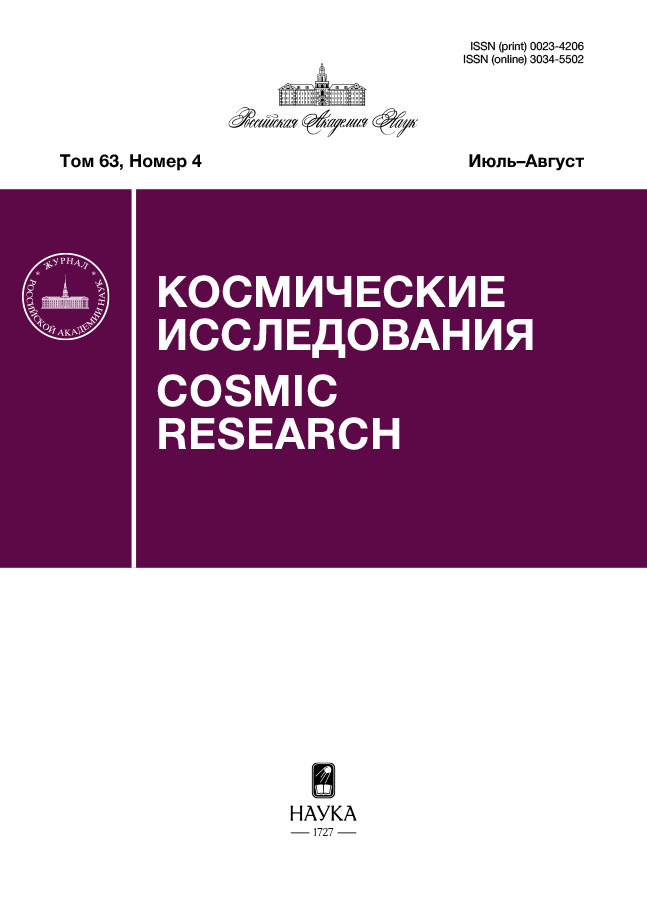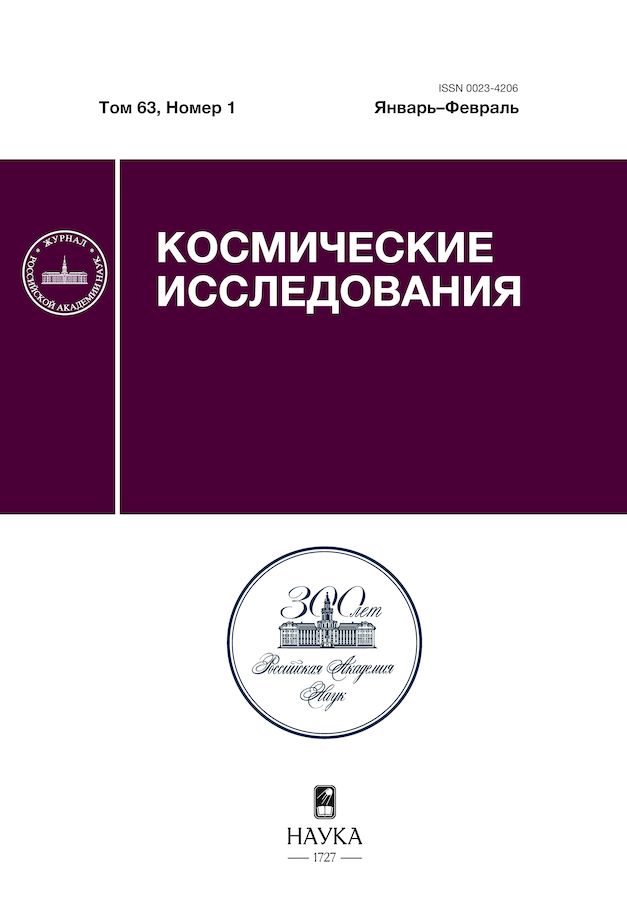Атмосферные потери N+ и O+ в экстремальных солнечных условиях во время геомагнитных инверсий
- Авторы: Царева О.О.1, Каннелл А.2, Левашов Н.Н.1,3, Малова Х.В.1,3, Попов В.Ю.1,3,4, Зеленый Л.М.1,3
-
Учреждения:
- Институт космических исследований РАН
- Университет Сан-Паулу
- МГУ имени М.В. Ломоносова
- Национальный исследовательский университет «Высшая школа экономики»
- Выпуск: Том 63, № 1 (2025)
- Страницы: 59–70
- Раздел: Статьи
- URL: https://gynecology.orscience.ru/0023-4206/article/view/682926
- DOI: https://doi.org/10.31857/S0023420625010061
- EDN: https://elibrary.ru/HECXIA
- ID: 682926
Цитировать
Полный текст
Аннотация
Согласно распространенным представлениям, магнитосфера защищает атмосферу планеты от эрозии, вызванной солнечным ветром. Ранее нами было показано, что во время геомагнитных инверсий, когда магнитное поле ослабевает примерно до 10 % от нынешнего, его защитная функция остается эффективной. Этот вывод был получен для спокойных периодов солнечной активности. Однако геомагнитная инверсия может длиться тысячи лет, в течение которых может произойти множество экстремальных событий, в частности, изменения солнечных параметров, таких как давление солнечного ветра, экстремальное ультрафиолетовое излучение (EUV). При высоком EUV-потоке в верхних слоях атмосферы Земли увеличиваются концентрации азота и кислорода, а также их потери. В настоящей работе рассмотрены наиболее значимые механизмы диссипации тяжелых ионов из атмосферы Земли и оценены их потери в рамках полуэмпирической модели. Показано, что слабое геомагнитное поле и сильная солнечная активность приводят к смене доминирующего механизма диссипации и к значительным атмосферным потерям сравнительно легких изотопов.
Полный текст
Об авторах
О. О. Царева
Институт космических исследований РАН
Автор, ответственный за переписку.
Email: olga8.92@mail.ru
Россия, Москва
А. Каннелл
Университет Сан-Паулу
Email: olga8.92@mail.ru
Институт перспективных исследований
Бразилия, Сан-ПаулуН. Н. Левашов
Институт космических исследований РАН; МГУ имени М.В. Ломоносова
Email: olga8.92@mail.ru
Физический факультет
Россия, Москва; МоскваХ. В. Малова
Институт космических исследований РАН; МГУ имени М.В. Ломоносова
Email: olga8.92@mail.ru
Научно-исследовательский институт ядерной физики им. Д.В. Скобельцына
Россия, Москва; МоскваВ. Ю. Попов
Институт космических исследований РАН; МГУ имени М.В. Ломоносова; Национальный исследовательский университет «Высшая школа экономики»
Email: olga8.92@mail.ru
Физический факультет
Россия, Москва; Москва; МоскваЛ. М. Зеленый
Институт космических исследований РАН; МГУ имени М.В. Ломоносова
Email: olga8.92@mail.ru
Научно-исследовательский институт ядерной физики им. Д.В. Скобельцына
Россия, Москва; МоскваСписок литературы
- Sepkoski J.J. Phanerozoic Overview of Mass Extinction // Patterns and Processes in the History of Life. 1986. P. 277–295. https://doi.org/ 10.1007/978-3-642-70831-2_15
- Keller G. Impacts, volcanism and mass extinction: random coincidence or cause and effect? // Australian J. Earth Sciences. 2005. V. 52 Iss. 4–5. P. 725–757. https://doi.org/10.1080/08120090500170393
- Raup D.M., Sepkoski J.J. Mass Extinctions in the Marine Fossil Record // Science. 1982. V. 215. Iss. 4539. P. 1501–1503. https://doi.org/10.1126/science.215.4539.1501
- Valet J.-P., Fournier A. Deciphering records of geomagnetic reversals // Reviews of Geophysics. 2016. V. 54. Iss. 2. P. 410–446. doi: 10.1002/2015RG000506
- Hounslow M.W., Domeier M., Biggin A.J. Subduction flux modulates the geomagnetic polarity reversal rate // Tectonophysics. 2018. Iss. 742. P. 34–49. https://doi.org/10.1016/j.tecto.2018.05.018
- Wei Y., Pu Z., Zong Q. et al. Oxygen escape from the Earth during geomagnetic reversals: Implications to mass extinction // Earth and Planetary Science Letters. 2014. Iss. 394. P. 94–98. https://doi.org/10.1016/j.epsl.2014.03.018
- Berner R.A. Phanerozoic atmospheric oxygen: New results using the GEOCARBSULF model // American J. Science. 2009. V. 309. Iss. 7. P. 603–606. https://doi.org/10.2475/07.2009.03
- Algeo T.J., Meyers P.A., Robinson R.S. et al. Icehouse-greenhouse variations in marine denitrification // Biogeosciences. 2014. V. 11. Iss. 4. P. 1273–1295. https://doi.org/10.5194/bg-11-1273-2014
- Johnson B.W., Goldblatt C. EarthN: A New Earth System Nitrogen Model // Geochemistry, Geophysics, Geosystems. 2018. V. 19. Iss. 8. P. 2516–2542. https://doi.org/10.1029/2017GC007392
- Cannell A.E.R. The engineering of the giant dragonflies of the Permian: revised body mass, power, air supply, thermoregulation and the role of air density // J. Exp. Biol. 2019. Iss. 221. Art.ID. jeb185405. https://doi.org/10.1242/jeb.185405
- Cannell A., Nel A. Paleo-air pressures and respiration of giant Odonatoptera from the Late Carboniferous to the Early Cretaceous // Palaeoentomology. 2023. V. 6. Iss. 4. https://doi.org/10.11646/palaeoentomology.6.4.6
- Cannell A.E.R. Too big to fly? An engineering evaluation of the fossil biology of the giant birds of the Miocene in relation to their flight limitations, constraining the minimum air pressure at about 1.3 bar // Animal Biology. 2020. V. 70. Iss. 3. P. 1–20. https://doi.org/10.1163/15707563-bja10001
- Cannell A., Blamey N., Brand U. et al. A revised sedimentary pyrite proxy for atmospheric oxygen in the paleozoic: Evaluation for the silurian-devonian-carboniferous period and the relationship of the results to the observed biosphere record // Earth-Science Reviews. 2022. Art. ID104062. https://doi.org/10.1016/j.earscirev.2022.104062
- Hoffman J.H., Dodson W.H., Lippincott C.R. et al. Initial ion composition results from the ISIS2 satellite // J. Geophysical Research (1896–1977). 1974. V. 79. Iss. 28. P. 4246–4251. https://doi.org/10.1029/JA079i028p04246
- Chappell C.R., Olsen R.C., Green J.L. et al. The discovery of nitrogen ions in the Earth’s magnetosphere // Geophysical Research Letters. 1982. V. 9. Iss. 9. P. 937–940. https://doi.org/10.1029/GL009i009p00937
- Cully C.M., Donovan E.F., Yau A.W. et al. Akebono / Suprathermal Mass Spectrometer observations of low-energy ion outflow: Dependence on magnetic activity and solar wind conditions // J. Geophysical Research (Space Physics). 2003. V. 108. Iss. A2. Art.ID. 1093. https://doi.org/10.1029/2001JA009200
- Tian F., Kasting J.F., Liu H.-L. et al. Hydrodynamic planetary thermosphere model: 1. Response of the Earth’s thermosphere to extreme solar EUV conditions and the significance of adiabatic cooling // J. Geophysical Research (Planets). 2008. V. 113. Iss. E5. Art.ID. E05008. https://doi.org/10.1029/2007JE002946.
- Chapman S. The absorption and dissociative or ionizing effect of monochromatic radiation in an atmosphere on a rotating Earth part II. grazing incidence // Proc. the Physical Society. 1931. V. 43. Iss. 5. P. 483–501. https://doi.org/10.1088/0959–5309/43/5/302
- Olivares-Pulido G., Hernández-Pajares M., Aragón- Angel A. et al. A linear scale height Chapman model supported by GNSS occultation measurements // J. Geophysical Research (Space Physics). 2016. V. 121. Iss. 8. P. 7932–7940. https://doi.org/10.1002/2016JA022337
- Tian F., Solomon S.C., Qian L. et al. Hydrodynamic planetary thermosphere model: 2. coupling of an electron transport/energy deposition model // J. Geophysical Research: Planets. 2008. V. 113. Iss. E7. https://doi.org/10.1029/2007JE003043
- Smithtro C.G., Sojka J.J. Behavior of the ionosphere and thermosphere subject to extreme solar cycle conditions // J. Geophysical Research (Space Physics). 2005. V. 110. Iss. A8. Art.ID. A08306. https://doi.org/10.1029/2004JA010782
- Lundin R., Dubinin E.M. Phobos-2 results on the ionospheric plasma escape from Mars // Advances in Space Research. 1992. Iss. 12. P. 255–263. https://doi.org/10.1016/0273-1177(92)90338-X
- Tsareva O.O., Dubinin E.M., Malova H.V. et al. Atmospheric escape from the earth during geomagnetic reversal // Ann. Geophys. 2019. V. 63. Iss. 2. Art.ID PA223. https://doi.org/10.4401/ag-8354
- Merrill R.T., McFadden P.L. Paleomagnetism and the nature of the geodynamo // Science. 1990. V. 248. Iss. 4953. P. 345–350. https://doi.org/10.1126/science.248.4953.345
- Leonhardt R., Fabian K. Paleomagnetic reconstruction of the global geomagnetic field evolution during the matuyama/brunhes transition // Earth and Planetary Science Letters. 2007. Iss. 253. P. 172–195. https://doi.org/10.1016/j.epsl.2006.10.025
- Valet J.-P., Thevarasan A., Bassinot F. et al. Two records of relative paleointensity for the past 4 Myr. // Frontiers in Earth Science. 2020. V. 8. Art.ID148. https://doi.org/10.3389/feart.2020.00148
- Herrero-Bervera E., Valet J.-P. Absolute paleointensity and reversal records from the Waianae sequence (Oahu, Hawaii, USA) // Earth and Planetary Science Letters. 2005. V. 234. Iss. 1–2. P. 279–296. https://doi.org/10.1016/j.epsl.2005.02.032
- Jacobs J.A. Reversals of the Earth’s magnetic field. 2nd edition. Cambridge: Cambridge Univ. Press, 1994.
- Glatzmaier G.A., Roberts P.H. A three-dimensional self-consistent computer simulation of a geomagnetic field reversal // Nature. 1995. V. 377. Iss. 6546. P. 203–209. https://doi.org/10.1038/377203a0
- Wood B.E., Muller H.-R., Zank G.P. et al. Measured mass-loss rates of solar-like stars as a function of age and activity // The Astrophysical J. 2002. V. 574. Iss. 1. P. 412–425. https://doi.org/10.1086/340797
- Güdel M., Kasting J. Origins and evolution of life: The young sun and its influence on planetary atmospheres. Cambridge: Cambridge University Press, 2011.
- Mansoori A., Khan P., Ahmad R. et al. Evaluation of long term solar activity effects on GPS derived tec. // J. Physics: Conference Series. 2016. V. 759. Art.ID012069. https://doi.org/10.1088/1742-6596/759/1/012069
- Krauss S., Pfleger M., Lammer H. Satellite-based analysis of thermosphere response to extreme solar flares // Annales Geophysicae. 2014. V. 32. Iss. 10. P. 1305–1309. https://doi.org/10.5194/angeo-32-1305-2014
- Yamauchi M., Wahlund J.-E. Role of the Ionosphere for the Atmospheric Evolution of Planets // Astrobiology. 2007. V. 7. Iss. 5. P. 783–800. https://doi.org/10.1089/ast.2007.0140
- Lundin R., Dubinin E.M., Koskinen H. et al. On the momentum transfer of the solar wind to the Martian topside ionosphere // Geophysical Research Letters. 1991. V. 18. Iss. 6. P. 1059–1062. https://doi.org/10.1029/90GL02604
- Lundin R., Lammer H., Ribas I. Planetary magnetic fields and solar forcing: Implications for atmospheric evolution // Space Science Reviews. 2007. V. 129. Iss. 1–3. P. 245–278. https://doi.org/10.1007/s11214-007-9176-4
- Brain D.A., Bagenal F., Ma Y.-J., et al. Atmospheric escape from unmagnetized bodies // J. Geophys. Res. Planets. 2016. V. 121. https://doi.org/10.1002/2016JE005162
- Gronoff G., Arras P., Baraka S. et al. Atmospheric escape processes and planetary atmospheric evolution: from misconceptions to challenges // Proc. European planetary science congress. 2020. EPSC2020–32. https://doi.org/10.5194/epsc2020-32
- Gunell H., Maggiolo R., Nilsson H. et al. Why an intrinsic magnetic field does not protect a planet against atmospheric escape // Astronomy and Astrophysics. 2018. V. 614. Iss. L3. https://doi.org/10.1051/0004-6361/201832934
- Seki K., Elphic R.C., Hirahara M. et al. On atmospheric loss of oxygen ions from Earth through magnetospheric processes // Science. 2001. V. 291. Iss. 5510. P. 1939–1941. https://doi.org/10.1126/science.1058913
- Slapak R., Hamrin M., Pitkänen T. et al. Quantification of the total ion transport in the near-Earth plasma sheet // Annales Geophysicae. 2017. V. 35. Iss. 4. P. 869–877. https://doi.org/10.5194/angeo-35-869-2017
- Slapak R., Schillings A., Nilsson H. et al. Atmospheric loss from the dayside open polar region and its dependence on geomagnetic activity: implications for atmospheric escape on evolutionary timescales // Annales Geophysicae. 2017. V. 35. Iss. 3. P. 721–731. https://doi.org/10.5194/angeo-35-721-2017
- Banks P.M., Holzer T.E. The polar wind // J. Geophysical Research. 1968. V. 73. Iss. 21. P. 6846–6854. https://doi.org/10.1029/JA073i021p06846
- Yau A.W., Abe T., Peterson W.K. The polar wind: Recent observations // J. Atmospheric and Solar-Terrestrial Physics. 2007. V. 69. Iss. 16. P. 1936–1983. https://doi.org/10.1016/j.jastp.2007.08.010
- Pierrard V., Lemaire J. Lorentzian ion exosphere model // J. Geophysical Research. 1996. V. 101. Iss. A4. P. 7923–7934. https://doi.org/10.1029/95JA03802
- Strangeway R.J., Ergun R.E., Su Y.-J. et al. Factors controlling ionospheric outflows as observed at intermediate altitudes // J. Geophysical Research (Space Physics). 2005. Iss. 110. Art.ID A03221. https://doi.org/10.1029/2004ja010829
- Fok M.-C., Ebihara Y., Moore T.E. Inner magnetospheric plasma interaction and coupling with the ionosphere // Adv. Polar Upper Atmos. Res. 2005. V. 19. P. 106–134.
- Pollock C.J., Chandler M.O., Moore T.E. et al. A survey of upwelling ion event characteristics // J. Geophys. Res. 1990. V. 95. Iss. A11. P. 18969–18980. https://doi.org/10.1029/JA095iA11p18969
- Perez-de-Tejada H. Momentum transport in the solar wind erosion of the Mars ionosphere // J. Geophysical Research: Planets. 1998. Iss. 103. P. 31499–31508. https://doi.org/10.1029/1998JE900001
- Perez-de-Tejada H. Solar wind-driven plasma flows in the Venus and Mars ionospheres // Advances in Space Research. 1992. V. 12. Iss. 9. P. 265–274. https://doi.org/10.1016/0273-1177(92)90339-Y
- Lammer H., Scherf M., Kurokawa H. et al. Loss and fractionation of noble gas isotopes and moderately volatile elements from planetary embryos and early Venus, Earth and Mars // Space Science Reviews. 2020. V. 216. Iss. 4. Art.ID. 74. https://doi.org/10.1007/s11214-020-00701-x
Дополнительные файлы
















